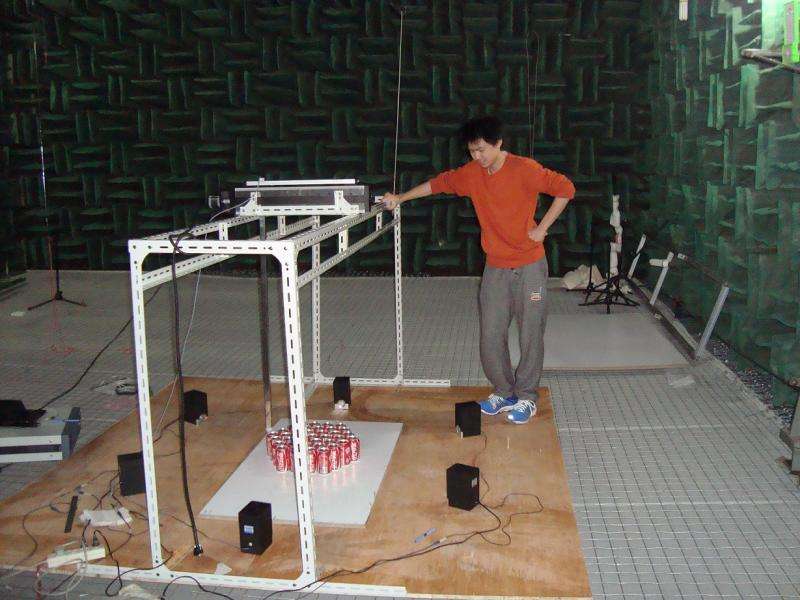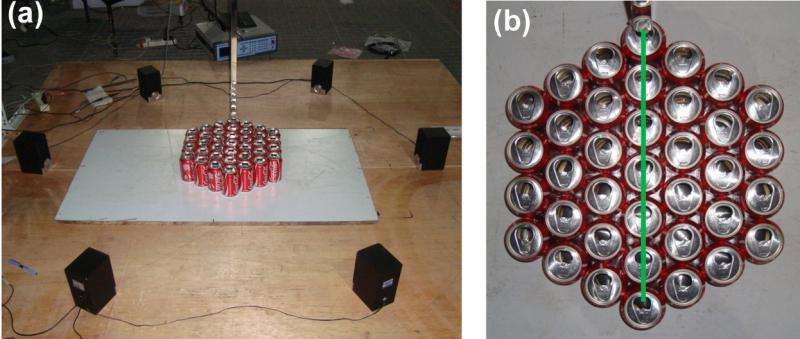April 28, 2015 feature
Soda can array revisited: It may not beat the diffraction limit after all

(Phys.org)—In 2011, scientists from the Institute Langevin in Paris built an array of 49 empty coke cans that resonate when exposed to an acoustic wave, causing the cans to produce sound similar to the way blowing across the top of an empty bottle produces sound. The researchers wanted to test the sound-focusing abilities of this array, which can be considered a metamaterial built of soda cans, whose properties depend on the structure of the array.
For any wave-focusing device—whether it be a microscope lens or a sound lens—the resolution is generally limited by the diffracting (bending) of the optical or acoustic waves. The resulting diffraction limit restricts the resolution to about half a wavelength. However, the researchers demonstrated that the soda can array can focus a 0.8-meter-long acoustic wave to a spot size of just a few centimeters, or about 1/25th the size of the acoustic wavelength—significantly beating the diffraction limit.
But now, four years later, scientists have found that the soda can array may not truly beat the diffraction limit, and further, it may not even work in the way that was originally thought.
In a paper published in the New Journal of Physics, A. A. Maznev, et al., from Nanjing University and MIT, have constructed an array of 37 empty coke cans and demonstrated that it can focus an acoustic wave to a spot size as small as 1/40 of the acoustic wavelength, making its focusing ability even stronger than in the previous work.

Despite this strong focusing, the scientists argue that neither study truly beats the diffraction limit. The problem lies in the fact that the above comparisons (1/25 and 1/40 the size of the wavelength) refer to the wavelength in air. The scientists explain that the comparison should instead be made with the wavelength of the acoustic wave in the soda can metamaterial, which becomes progressively smaller as the acoustic frequency approaches the resonant frequency of the cans from below.
Furthermore, they found that the technique used in the previous study, called time reversal, which was thought to be crucial for the sharp focusing, is not a fundamental requirement.
In both set-ups, the array of cans is surrounded by several speakers. However, in the array that used time reversal, a microphone placed above a can was used to emit a short sound pulse. Each speaker recorded a signal originating from this pulse, and then each speaker played back its own signal in reverse. When receiving the playback, the only can that resonated was the one from which the sound was originally captured. Everywhere else, the waves cancelled out.
Although it was thought that the time reversal technique was essential for achieving the extreme focusing, the technique used in the new study is more straightforward: six speakers surrounding the array produce sound at a single frequency that continually increases. When the frequency approaches the cans' resonant frequency of 420 Hz, the focal spot at the center of the array becomes progressively smaller, as measured by a microphone hanging overhead.
The researchers' analysis reveals that the principal reason for the sharp focusing is the same in both studies: the wavelength of the acoustic wave propagating above the array gets progressively shorter as its frequency approaches the Helmholtz resonance of the cans. In other words, the focusing effect is a result of the resonant nature of the metamaterial, and not a result of time reversal. The researchers explained that conventional materials don't have acoustic resonances because atoms or molecules do not resonate at acoustic frequencies. However, using artificial building blocks such as soda cans, it's possible to build locally resonant metamaterials with tailored properties that don't have analogues in nature.
Although time reversal may not be essential for achieving the sharp focusing, the technique still has undisputed advantages. For instance, time reversal allows the researchers to control the acoustic waves to focus on any chosen can, and it does not require the can array to have a specific shape. In contrast, the array that does not use time reversal must be shaped as a lens—in the current study the researchers used a hexagonal array approximating a circle.
Although the researchers don't see any direct practical applications of the soda can array for now, they note that there's a certain educational value because the soda cans make a nice model system of a metamaterial: a metamaterial built of soda cans is just like a natural material built of atoms, but in this case the metamaterial can exhibit some remarkable acoustic properties.
More information: A. A. Maznev, et al. "Extraordinary focusing of sound above a soda can array without time reversal." New Journal of Physics. DOI: 10.1088/1367-2630/17/4/042001
Journal information: New Journal of Physics
© 2015 Phys.org





















